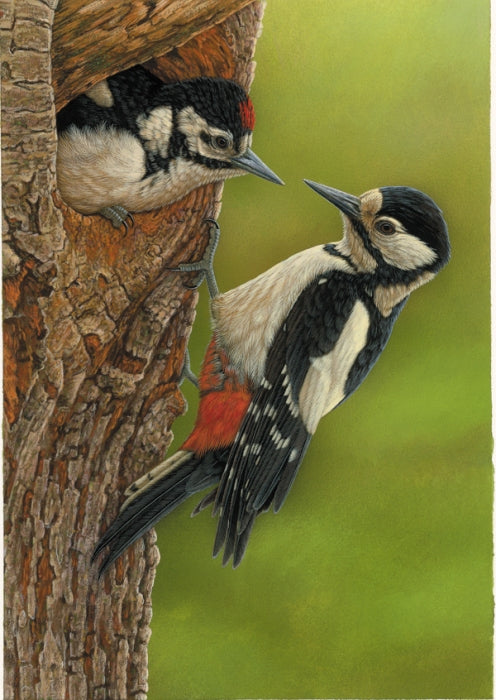 Woodpecker and Chick, painting by Robert E Fuller.
Woodpecker and Chick, painting by Robert E Fuller.Woodpeckers usually nest either in dark woodland or high up in the trees where they are difficult to photograph. But a few years ago a friend called me to tell me about a woodpecker nest that was only 15ft up a in an isolated tree where I could easily photograph it. All I needed was a hide up to be able to watch the nest without disturbing the woodpeckers. My friend helped me make a tower out of two potato boxes five metres away from the nest. We put a hide on top of it so that I could look into the nest hole at eye level. As we did this the female woodpecker ignored us and continued to feed her chicks. The male was less sure at first. He peered at my potato box hide and at the lens sticking out of it from a nearby branch. But, he soon got used to it.

The woodpeckers foraged for food in leaves and on the tips of branches and brought back beaks full of tiny green aphids. I hadn’t ever seen this behaviour before. As the chicks got bigger, so did the food that the parents brought in. Caterpillars were favourites. But when it was windy they couldn’t catch caterpillars so they concentrated on finding wood-boring grubs under the bark instead. A part of one particular tree was decaying and must have been infested with them. I watched how the woodpecker angled his head deftly so that he could chip off the bark with his beak.

It was like watching a master craftsman at work. He would stop, listen and then chip away again before gently teasing the grubs out with his 20cm long tongue. In between feeding the male still had territorial duties to attend to. He would head up into some dead branches and drum against the wood up to 20 times a second. This is a common sound heard in any woodland, but I had never been close enough to witness it. After three weeks of watching I saw the beaks of the young chicks poking out of the perfectly excavated entrance hole. The chicks had been cheeping continuously, but as they grew older and wiser they only cheeped when they sensed the parents landing on the trunk – which certainly made life easier for me to photograph them.

I was waiting for one crucial photographic opportunity – the moment when the chicks poked their heads out of the hole and the adults fed them. But work commitments meant I couldn’t be there 24/7. On top of this the weather changed for the worse, blowing the top off my hide and making the whole structure unstable. After three days the weather abated and I was back. I returned to find a dead chick at the base of the tree – perhaps the adults couldn’t find enough food to feed the chicks during the bad spell, but the others were thriving. Within five hours I had got a photograph of the male with a beak stuffed full of grubs feeding a chick from the entrance hole, which I was extremely pleased about.

I returned the following day to get some more shots. When I got there I found that one chick was frantic with hunger, poking its head out of the hole and calling constantly. But there was no sign of the adults for two hours. When the male did finally turn up it came bearing no food, which was strange. The male called at the chick and the chick now desperate for food called back, but the male simply flew off. I started to wonder if I was somehow disturbing their normal routine so I moved my car further down the track. As I got out of the car I could hear a chick calling from high up in the tree and I realised that one of the chicks had already fledged. The parents let out an alarm call as I approached and the young fledgling froze.
I realised that the adults were purposefully withholding food to encourage the chick out of the hole. Eventually the chick took a leap of faith and emerged in an ungainly manner, somersaulting out of the hole before splaying its wings on the trunk and clinging to the bark. It paused for a moment before regaining its posture and heading up the trunk to join its father, which immediately feed the chick by way of reward for its bravery. The hole fell silent, I’d just seen the last chick fledge and the project was over and what a finale!
Below and above are two painting this experience inspired.
 Woodpecker and Chick, painted by Robert E Fuller.
Woodpecker and Chick, painted by Robert E Fuller. Woodpecker at Fotherdale, art print by Robert E Fuller. Click to buy.
Woodpecker at Fotherdale, art print by Robert E Fuller. Click to buy.














